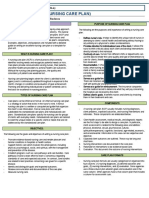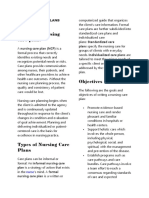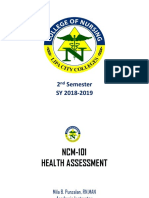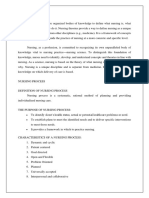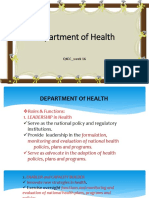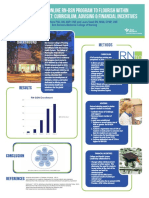NURSING CARE PLANS: Ultimate Guide and Database
NURSING CARE PLANS: Ultimate Guide and Database
Uploaded by
Carl Josef C. GarciaCopyright:
Available Formats
NURSING CARE PLANS: Ultimate Guide and Database
NURSING CARE PLANS: Ultimate Guide and Database
Uploaded by
Carl Josef C. GarciaOriginal Title
Copyright
Available Formats
Share this document
Did you find this document useful?
Is this content inappropriate?
Copyright:
Available Formats
NURSING CARE PLANS: Ultimate Guide and Database
NURSING CARE PLANS: Ultimate Guide and Database
Uploaded by
Carl Josef C. GarciaCopyright:
Available Formats
1
Northeastern College- College of Nursing
ENRIQUEZ R. CAYABAN, RN, LPT, MAN (Clinical Intructor)
NURSING CARE PLANS: Ultimate Guide and Database
Writing the best nursing care plan requires a step-by-step approach to correctly
complete the parts needed for a care plan.
NURSING CARE PLAN
A nursing care plan (NCP) is a formal process that includes correctly identifying
existing needs, as well as recognizing potential needs or risks. Care plans also provide a
means of communication among nurses, their patients, and other healthcare providers to
achieve health care outcomes. Without the nursing care planning process, quality and
consistency in patient care would be lost.
Nursing care planning begins when the client is admitted to the agency and is
continuously updated throughout in response to client’s changes in condition and
evaluation of goal achievement. Planning and delivering individualized or patient-
centered care is the basis for excellence in nursing practice.
TYPES OF NURSING CARE PLAN
Care plans can be informal or formal: Informal nursing care plan is a strategy of
action that exists in the nurse‘s mind. A formal nursing care plan is a written or
computerized guide that organizes information about the client’s care. Formal care plans
are further subdivided into standardized care plan, and individualized care plan:
Standardized care plans specify the nursing care for groups of clients with
everyday needs.
Individualized care plans are tailored to meet the unique needs of a specific client
or needs that are not addressed by the standardized care plan.
OBJECTIVES
The following are the goals and objectives of writing a nursing care plan:
Promote evidence-based nursing care and to render pleasant and familiar
conditions in hospitals or health centers.
Support holistic care which involves the whole person including physical,
psychological, social and spiritual in relation to management and prevention of the
disease.
Establish programs such as care pathways and care bundles. Care pathways
involve a team effort in order to come to a consensus with regards to standards of
care and expected outcomes while care bundles are related to best practice with
regards to care given for a specific disease.
Identify and distinguish goals and expected outcome.
Review communication and documentation of the care plan.
Measure nursing care.
PURPOSE OF NURSING CARE PLAN
The following are the purposes and importance of writing a nursing care plan:
Defines nurse’s role. It helps to identify the unique role of nurses in attending the
overall health and well-being of clients without having to rely entirely on a
physician’s orders or interventions.
Provides direction for individualized care of the client. It allows the nurse to
think critically about each client and to develop interventions that are directly
tailored to the individual.
NURSING CARE PROCESS- Developing A Nursing Care Plan
CHN 1 BSN 2 Related Learning Experience
2
Northeastern College- College of Nursing
ENRIQUEZ R. CAYABAN, RN, LPT, MAN (Clinical Intructor)
Continuity of care. Nurses from different shifts or different floors can use the data
to render the same quality and type of interventions to care for clients, therefore
allowing clients to receive the most benefit from treatment.
Documentation. It should accurately outline which observations to make, what
nursing actions to carry out, and what instructions the client or family members
require. If nursing care is not documented correctly in the care plan, there is no
evidence the care was provided.
Serves as guide for assigning a specific staff to a specific client. There are
instances when client’s care needs to be assigned to a staff with particular and
precise skills.
Serves as guide for reimbursement. The medical record is used by the
insurance companies to determine what they will pay in relation to the hospital care
received by the client.
Defines client’s goals. It does not only benefit nurses but also the clients by
involving them in their own treatment and care.
COMPONENTS
A nursing care plan (NCP) usually includes nursing diagnoses, client problems,
expected outcomes, and nursing interventions and rationales. These components are
elaborated below:
1. Client health assessment, medical results, and diagnostic reports. This is the first
measure in order to be able to design a care plan. In particular, client assessment
is related to the following areas and abilities: physical, emotional, sexual,
psychosocial, cultural, spiritual/transpersonal, cognitive, functional, age-related,
economic and environmental. Information in this area can be subjective and
objective.
2. Expected client outcomes are outlined. These may be long and short term.
3. Nursing interventions are documented in the care plan.
4. Rationale for interventions in order to be evidence-based care.
5. Evaluation. This documents the outcome of nursing interventions.
CARE PLAN FORMATS
Nursing care plan formats are usually categorized or organized into four columns:
(1) nursing diagnoses, (2) desired outcomes and goals, (3) nursing interventions, and (4)
evaluation. Some agencies use a three-column plan wherein goals and evaluation are in
the same column. Other agencies have a five-column plan that includes a column for
assessment cues.
NURSING CARE PROCESS- Developing A Nursing Care Plan
CHN 1 BSN 2 Related Learning Experience
3
Northeastern College- College of Nursing
ENRIQUEZ R. CAYABAN, RN, LPT, MAN (Clinical Intructor)
STUDENT CARE PLANS
Student care plans are more lengthy and detailed than care plans used by working
nurses because they are a learning activity for the students.
NURSING CARE PROCESS- Developing A Nursing Care Plan
CHN 1 BSN 2 Related Learning Experience
4
Northeastern College- College of Nursing
ENRIQUEZ R. CAYABAN, RN, LPT, MAN (Clinical Intructor)
WRITING NURSING CARE PLANS
Step 1: Data Collection or Assessment
The first step in writing a nursing care plan is to create a client database using
assessment techniques and data collection methods (physical assessment, health
history, interview, medical records review, and diagnostic studies). A client database
includes all the health information gathered. In this step, the nurse can identify the related
or risk factors and defining characteristics that can be used to formulate a nursing
diagnosis. Some agencies or nursing schools have their own assessment formats you
can use.
Step 2: Data Analysis and Organization
Now that you have information about the client’s health, analyze, cluster, and
organize the data to formulate your nursing diagnosis, priorities, and desired outcomes.
Step 3: Formulating Your Nursing Diagnoses
NANDA nursing diagnoses are a uniform way of identifying, focusing on, and
dealing with specific client needs and responses to actual and high-risk problems. Actual
or potential health problems that can be prevented or resolved by independent nursing
intervention are termed nursing diagnoses.
Step 4: Setting Priorities
Setting priorities is the process of establishing a preferential sequence for address
nursing diagnoses and interventions. In this step, the nurse and the client begin planning
which nursing diagnosis requires attention first. Diagnoses can be ranked and grouped
as to having a high, medium, or low priority. Life-threatening problems should be given
high priority.
NURSING CARE PROCESS- Developing A Nursing Care Plan
CHN 1 BSN 2 Related Learning Experience
5
Northeastern College- College of Nursing
ENRIQUEZ R. CAYABAN, RN, LPT, MAN (Clinical Intructor)
Maslow's Hierarchy of Needs for Setting Priorities in NCP
Maslow’s hierarchy of needs is frequently used when setting priorities.
Client’s health values and beliefs, client’s own priorities, resources available, and
urgency are some of the factors the nurse must consider when assigning priorities.
Involve the client in the process to enhance cooperation.
Step 5: Establishing Client Goals and Desired Outcomes
After assigning priorities for your nursing diagnosis, the nurse and the client set
goals for each determined priority. Goals or desired outcomes describe what the nurse
hopes to achieve by implementing the nursing interventions and are derived from the
client’s nursing diagnoses. Goals provide direction for planning interventions, serve as
criteria for evaluating client progress, enable the client and nurse to determine which
problems have been resolved, and help motivate the client and nurse by providing a
sense of achievement.
One overall goal is determined for each nursing diagnosis. The terms goal,
outcome, and expected outcome are oftentimes used interchangeably.
Short Term and Long Term Goals
Goals and expected outcomes must be measurable and client-centered. Goals are
constructed by focusing on problem prevention, resolution, and/or rehabilitation. Goals
NURSING CARE PROCESS- Developing A Nursing Care Plan
CHN 1 BSN 2 Related Learning Experience
6
Northeastern College- College of Nursing
ENRIQUEZ R. CAYABAN, RN, LPT, MAN (Clinical Intructor)
can be short term or long term. In an acute care setting, most goals are short-term since
much of the nurse’s time is spent on the client’s immediate needs. Long-term goals are
often used for clients who have chronic health problems or who live at home, in nursing
homes, or extended care facilities.
Short-term goal – a statement distinguishing a shift in behavior that can be
completed immediately, usually within a few hours or days.
Long-term goal – indicates an objective to be completed over a longer period,
usually over weeks or months.
Discharge planning – involves naming long-term goals, therefore promoting
continued restorative care and problem resolution through home health, physical
therapy, or various other referral sources.
Components of Goals and Desired Outcomes
Goals or desired outcome statements usually have the four components: a subject,
a verb, conditions or modifiers, and criterion of desired performance.
Subject. The subject is the client, any part of the client, or some attribute of the
client (i.e., pulse, temperature, urinary output). That subject is often omitted in
writing goals because it is assumed that the subject is the client unless indicated
otherwise (family, significant other).
Verb. The verb specifies an action the client is to perform, for example, what the
client is to do, learn, or experience.
Conditions or modifiers. These are the “what, when, where, or how” that are
added to the verb to explain the circumstances under which the behavior is to be
performed.
Criterion of desired performance. The criterion indicates the standard by which
a performance is evaluated or the level at which the client will perform the specified
behavior. These are optional.
When writing goals and desired outcomes, the nurse should follow these tips:
1. Write goals and outcomes in terms of client responses and not as activities of the
nurse. Begin each goal with “Client will […]” help focus the goal on client behavior and
responses.
2. Avoid writing goals on what the nurse hopes to accomplish, and focus on what the
client will do.
3. Use observable, measurable terms for outcomes. Avoid using vague words that
require interpretation or judgment of the observer.
NURSING CARE PROCESS- Developing A Nursing Care Plan
CHN 1 BSN 2 Related Learning Experience
7
Northeastern College- College of Nursing
ENRIQUEZ R. CAYABAN, RN, LPT, MAN (Clinical Intructor)
4. Desired outcomes should be realistic for the client’s resources, capabilities,
limitations, and on the designated time span of care.
5. Ensure that goals are compatible with the therapies of other professionals.
6. Ensure that each goal is derived from only one nursing diagnosis. Keeping it this way
facilitates evaluation of care by ensuring that planned nursing interventions are clearly
related to the diagnosis set.
7. Lastly, make sure that the client considers the goals important and values them to
ensure cooperation.
Step 6: Selecting Nursing Interventions
Nursing interventions are activities or actions that a nurse performs to achieve
client goals. Interventions chosen should focus on eliminating or reducing the etiology of
the nursing diagnosis. As for risk nursing diagnoses, interventions should focus on
reducing the client’s risk factors. In this step, nursing interventions are identified and
written during the planning step of the nursing process; however, they are actually
performed during the implementation step.
Types of Nursing Interventions
Nursing interventions can be independent, dependent, or collaborative:
Independent nursing interventions are activities that nurses are licensed to
initiate based on their sound judgement and skills. Includes: ongoing assessment,
emotional support, providing comfort, teaching, physical care, and making referrals
to other health care professionals.
Dependent nursing interventions are activities carried out under the physician’s
orders or supervision. Includes orders to direct the nurse to provide medications,
intravenous therapy, diagnostic tests, treatments, diet, and activity or rest.
Assessment and providing explanation while administering medical orders are also
part of the dependent nursing interventions.
NURSING CARE PROCESS- Developing A Nursing Care Plan
CHN 1 BSN 2 Related Learning Experience
8
Northeastern College- College of Nursing
ENRIQUEZ R. CAYABAN, RN, LPT, MAN (Clinical Intructor)
Collaborative interventions are actions that the nurse carries out in collaboration
with other health team members, such as physicians, social workers, dietitians,
and therapists. These actions are developed in consultation with other health care
professionals to gain their professional viewpoint.
Safe and appropriate for the client’s age, health, and condition.
Achievable with the resources and time available.
Inline with the client’s values, culture, and beliefs.
Inline with other therapies.
Based on nursing knowledge and experience or knowledge from relevant
sciences.
When writing nursing interventions, follow these tips:
1. Write the date and sign the plan. The date the plan is written is essential for evaluation,
review, and future planning. The nurse’s signature demonstrates accountability.
2. Nursing interventions should be specific and clearly stated, beginning with an action
verb indicating what the nurse is expected to do. Action verb starts the intervention
and must be precise. Qualifiers of how, when, where, time, frequency, and amount
provide the content of the planned activity. For example: “Educate parents on how to
take temperature and notify of any changes,” or “Assess urine for color, amount, odor,
and turbidity.”
3. Use only abbreviations accepted by the institution.
Step 7: Providing Rationale
Rationales, also known as scientific explanation, are the underlying reasons for
which the nursing intervention was chosen for the NCP.
Rationales do not appear in regular care plans, they are included to assist nursing
students in associating the pathophysiological and psychological principles with the
selected nursing intervention.
NURSING CARE PROCESS- Developing A Nursing Care Plan
CHN 1 BSN 2 Related Learning Experience
9
Northeastern College- College of Nursing
ENRIQUEZ R. CAYABAN, RN, LPT, MAN (Clinical Intructor)
Step 8: Evaluation
Evaluating is a planned, ongoing, purposeful activity in which the client’s progress
towards the achievement of goals or desired outcomes, and the effectiveness of the
nursing care plan (NCP). Evaluation is an important aspect of the nursing process
because conclusions drawn from this step determine whether the nursing intervention
should be terminated, continued, or changed.
Step 9: Putting it on Paper
The client’s NCP is documented according to hospital policy and becomes part of
the client’s permanent medical record which may be reviewed by the oncoming nurse.
Different nursing programs have different care plan formats, most are designed so that
the student systematically proceeds through the interrelated steps of the nursing process,
and many use a five-column format.
REFERENCE
Vera, Matt (2020). Nursing Care Plans (NCP): Ultimate Guide and Database.
Accessed on September 15, 2020. Available at https://nurseslabs.com/nursing-care-
plans/#:~:text=A%20nursing%20care%20plan%20(NCP)%20is%20a%20formal%20pro
cess%20that,to%20achieve%20health%20care%20outcomes.
NURSING CARE PROCESS- Developing A Nursing Care Plan
CHN 1 BSN 2 Related Learning Experience
You might also like
- Care Coordination: A Blueprint for Action for RNs: A Blueprint for Action for RNsFrom EverandCare Coordination: A Blueprint for Action for RNs: A Blueprint for Action for RNsNo ratings yet
- Nursing Care PlanDocument12 pagesNursing Care PlanGladys Tamayo100% (1)
- Year: Not Applicable: I. Major OperationsDocument5 pagesYear: Not Applicable: I. Major Operationsayhab abinaNo ratings yet
- Nursing Application LetterDocument1 pageNursing Application Letterrjalavazo1989100% (3)
- Week 1 - Module 1nursing Care PlanDocument5 pagesWeek 1 - Module 1nursing Care PlanMARK JEFTE BRIONESNo ratings yet
- Types of Nursing Care PlanDocument7 pagesTypes of Nursing Care PlanSuzete PagaduanNo ratings yet
- Nursing Care Plan (NCP) - Ultimate Guide and Database - NurseslabsDocument23 pagesNursing Care Plan (NCP) - Ultimate Guide and Database - NurseslabsJOSHUA DICHOSO100% (1)
- Module 1 REVIEW OF THE NURSING PROCESS 1Document3 pagesModule 1 REVIEW OF THE NURSING PROCESS 1hamisi100% (2)
- Nursing Care Plan and Nightingale's Environmental TheoryDocument4 pagesNursing Care Plan and Nightingale's Environmental TheoryBALDOZA LEO FRANCO B.No ratings yet
- Nursing Care PlansDocument16 pagesNursing Care PlansSantos Kyla Patricia T.No ratings yet
- Unit 1 (C) Nursing ProcessDocument43 pagesUnit 1 (C) Nursing ProcessSumaira NoreenNo ratings yet
- Nursing Process ReportDocument30 pagesNursing Process ReportJoanne CareahNo ratings yet
- Module I - Group Work (Edited)Document21 pagesModule I - Group Work (Edited)Nur SanaaniNo ratings yet
- Nursing Management NSC 410Document36 pagesNursing Management NSC 410falodun miracleNo ratings yet
- Konsep Proses KeperawatanDocument20 pagesKonsep Proses KeperawatanriskaNo ratings yet
- Nursing Care Plans ...Document16 pagesNursing Care Plans ...Santos Kyla Patricia T.No ratings yet
- Nursing Care Plan (11139)Document49 pagesNursing Care Plan (11139)Jay Debby RuizoNo ratings yet
- Decena, Cyrille Justine A. BSN-1A NCM 100 Lec - HomeworkDocument9 pagesDecena, Cyrille Justine A. BSN-1A NCM 100 Lec - HomeworkCyrille DecenaNo ratings yet
- Module 5 Nursing ProcessDocument34 pagesModule 5 Nursing Processscrewdriver100% (5)
- DengDocument1 pageDengmangubatzonethNo ratings yet
- RLE - NCP Ultimate Guide (Review)Document82 pagesRLE - NCP Ultimate Guide (Review)Zoè AshtrönNo ratings yet
- Nursing Care Plans (NCP) : Ultimate Guide and DatabaseDocument2 pagesNursing Care Plans (NCP) : Ultimate Guide and DatabaseRana AlaseeriNo ratings yet
- Nursing Care PlanDocument4 pagesNursing Care Planyunusarebecca0No ratings yet
- Nursingprocessfinal 240210230023 8c3ed2deDocument36 pagesNursingprocessfinal 240210230023 8c3ed2deJoseph PhiriNo ratings yet
- Module I Group WorkDocument6 pagesModule I Group WorkNur Sanaani100% (1)
- CU02A WEEK02-NursingProcessinPMHNPractice28VAL2928129MODULEDocument8 pagesCU02A WEEK02-NursingProcessinPMHNPractice28VAL2928129MODULEduca.danrainer02No ratings yet
- Reviewer DutyDocument9 pagesReviewer DutySantos Kyla Patricia T.No ratings yet
- Formulation of Care Plan: BY:-Firoz Qureshi Dept. Psychiatric NursingDocument28 pagesFormulation of Care Plan: BY:-Firoz Qureshi Dept. Psychiatric NursingTni Jolie100% (1)
- QualityNursingCare IdealsRealitiesImplicationsDocument17 pagesQualityNursingCare IdealsRealitiesImplicationsdanetimbuk901No ratings yet
- Nursing Process Funda Lec SemisDocument8 pagesNursing Process Funda Lec Semissummer.monthxxNo ratings yet
- Module I - Group WorkDocument6 pagesModule I - Group WorkNur SanaaniNo ratings yet
- Nursingcaredelivery 181011144230Document50 pagesNursingcaredelivery 181011144230Nithin RamNo ratings yet
- The Nursing Process OverviewDocument26 pagesThe Nursing Process OverviewAYO NELSONNo ratings yet
- AKIN OTIKO B O Quality Nursing Care in NigeriaThe Ideals Realities and ImplicationsDocument19 pagesAKIN OTIKO B O Quality Nursing Care in NigeriaThe Ideals Realities and ImplicationsUmar Farouq Mohammed GalibNo ratings yet
- 2 Semester SY 2018-2019Document68 pages2 Semester SY 2018-2019Cludeth Marjorie FiedalanNo ratings yet
- Theories, Models in ObgDocument83 pagesTheories, Models in ObgSyama Aneesh100% (1)
- NCM 103 Midterm Review Material - 013138Document28 pagesNCM 103 Midterm Review Material - 013138kessiabon459No ratings yet
- Staffing Group 2 ReportDocument47 pagesStaffing Group 2 ReportDianna MV CoerbsNo ratings yet
- NCLEX-RN Test Plan 2016Document11 pagesNCLEX-RN Test Plan 2016CrystalFletcherMoylanNo ratings yet
- Leadership & Management - NCOMAPDocument4 pagesLeadership & Management - NCOMAPclaudine padillonNo ratings yet
- 001 - Nida Najiyah - NURSING PROCESS AS A SCIENTIFIC METHOD IN PROBLEM SOLVING - Id.enDocument7 pages001 - Nida Najiyah - NURSING PROCESS AS A SCIENTIFIC METHOD IN PROBLEM SOLVING - Id.enChristine HevinNo ratings yet
- Nursing ProcessDocument4 pagesNursing ProcessAngelrica TumbadoNo ratings yet
- Nursing Process Unit-4Document27 pagesNursing Process Unit-4Rashid HussainNo ratings yet
- 440 SelfassessDocument20 pages440 Selfassessapi-234511817No ratings yet
- Nursing Modalities CAREDocument76 pagesNursing Modalities CARENeph March 2022No ratings yet
- Review of Nursing Plan ANPIEDocument2 pagesReview of Nursing Plan ANPIEJenn WardNo ratings yet
- Nursing ProcessDocument62 pagesNursing ProcessplethoraldorkNo ratings yet
- NCM 119 Lesson 3 Patient Care Delivery SystemDocument66 pagesNCM 119 Lesson 3 Patient Care Delivery Systeminno so qtNo ratings yet
- Self AssessmentDocument10 pagesSelf Assessmentapi-240352043No ratings yet
- Nursing ProcessDocument62 pagesNursing ProcessMara MaraNo ratings yet
- Group Work ActivityDocument9 pagesGroup Work Activityjessie marietanNo ratings yet
- Steps in Making A Family Nursing Care PlanDocument4 pagesSteps in Making A Family Nursing Care PlanMary Lou100% (2)
- IMMUNOTHERAPYDocument24 pagesIMMUNOTHERAPYmmmartinez1583No ratings yet
- Crunch Time Review for the Certified Nursing Assistant (CNA) ExamFrom EverandCrunch Time Review for the Certified Nursing Assistant (CNA) ExamNo ratings yet
- NCLEX-RN Exam Prep 2024-2025: 500 NCLEX-RN Test Prep Questions and Answers with ExplanationsFrom EverandNCLEX-RN Exam Prep 2024-2025: 500 NCLEX-RN Test Prep Questions and Answers with ExplanationsNo ratings yet
- NCLEX-RN Exam Practice Questions 2024-2025:700 Practice Questions Including 2 Full-Length Practice Exams with Detailed Answers and ExplanationsFrom EverandNCLEX-RN Exam Practice Questions 2024-2025:700 Practice Questions Including 2 Full-Length Practice Exams with Detailed Answers and ExplanationsNo ratings yet
- Health Care Delivery Manager- The Comprehensive Guide: Vanguard ProfessionalsFrom EverandHealth Care Delivery Manager- The Comprehensive Guide: Vanguard ProfessionalsNo ratings yet
- 1200 NCLEX-RN Exam Practice Questions and Answers: Includes 4 Full-Length Practice Test Exams for Exam SuccessFrom Everand1200 NCLEX-RN Exam Practice Questions and Answers: Includes 4 Full-Length Practice Test Exams for Exam SuccessNo ratings yet
- Correctional Nursing: Scope and Standards of Practice, Third EditionFrom EverandCorrectional Nursing: Scope and Standards of Practice, Third EditionRating: 5 out of 5 stars5/5 (1)
- Next Generation NCLEX-PN Prep 2023-2024: Practice Test + Proven StrategiesFrom EverandNext Generation NCLEX-PN Prep 2023-2024: Practice Test + Proven StrategiesNo ratings yet
- Nutri Lab 10Document38 pagesNutri Lab 10Carl Josef C. GarciaNo ratings yet
- Nutrition: Pregnancy AND Lactation: Enriquez R. Cayaban, RN, LPT, MANDocument44 pagesNutrition: Pregnancy AND Lactation: Enriquez R. Cayaban, RN, LPT, MANCarl Josef C. GarciaNo ratings yet
- Nutri Lec 10Document47 pagesNutri Lec 10Carl Josef C. GarciaNo ratings yet
- Infancy: Enriquez R. Cayaban, RN, LPT, Man InstructorDocument37 pagesInfancy: Enriquez R. Cayaban, RN, LPT, Man InstructorCarl Josef C. GarciaNo ratings yet
- Adolescence Adulthood Elderhood: Enriquez R. Cayaban, RN, LPT, ManDocument27 pagesAdolescence Adulthood Elderhood: Enriquez R. Cayaban, RN, LPT, ManCarl Josef C. GarciaNo ratings yet
- Bioethics 2Document37 pagesBioethics 2Carl Josef C. GarciaNo ratings yet
- Easy-To-Prepare Baby FoodsDocument5 pagesEasy-To-Prepare Baby FoodsCarl Josef C. GarciaNo ratings yet
- Childhood: Enriquez R. Cayaban, RN, LPT, MANDocument26 pagesChildhood: Enriquez R. Cayaban, RN, LPT, MANCarl Josef C. GarciaNo ratings yet
- Pharma 1Document42 pagesPharma 1Carl Josef C. GarciaNo ratings yet
- Pharma 3Document54 pagesPharma 3Carl Josef C. GarciaNo ratings yet
- Pharma YtDocument24 pagesPharma YtCarl Josef C. GarciaNo ratings yet
- CHN 1 LEC Week 16Document44 pagesCHN 1 LEC Week 16Carl Josef C. GarciaNo ratings yet
- Routine Nutrition Therapy: Enriquez R. Cayaban, RN, LPT, ManDocument45 pagesRoutine Nutrition Therapy: Enriquez R. Cayaban, RN, LPT, ManCarl Josef C. GarciaNo ratings yet
- CMCA LEC 12-IntrapartumDocument189 pagesCMCA LEC 12-IntrapartumCarl Josef C. GarciaNo ratings yet
- Cmca Rle 13Document126 pagesCmca Rle 13Carl Josef C. GarciaNo ratings yet
- CHN Rle History of Herbal MedDocument4 pagesCHN Rle History of Herbal MedCarl Josef C. GarciaNo ratings yet
- CMCA LEC 9-Antepartum Pregnancy - Part2 - Week 4Document34 pagesCMCA LEC 9-Antepartum Pregnancy - Part2 - Week 4Carl Josef C. GarciaNo ratings yet
- CHN LEC 1 Week 7Document31 pagesCHN LEC 1 Week 7Carl Josef C. GarciaNo ratings yet
- CHN LEC 1 Week 5-6Document39 pagesCHN LEC 1 Week 5-6Carl Josef C. GarciaNo ratings yet
- CMCA LEC 10-Antepartum Pregnancy - Part3 - Week4Document101 pagesCMCA LEC 10-Antepartum Pregnancy - Part3 - Week4Carl Josef C. GarciaNo ratings yet
- A Model of Global Communication CompetenceDocument4 pagesA Model of Global Communication CompetenceCarl Josef C. GarciaNo ratings yet
- Globalization Boarderless NursingDocument2 pagesGlobalization Boarderless NursingCarl Josef C. GarciaNo ratings yet
- CHN Rle 4Document41 pagesCHN Rle 4Carl Josef C. GarciaNo ratings yet
- Theoritical Foundation of NursingDocument6 pagesTheoritical Foundation of NursingCarl Josef C. GarciaNo ratings yet
- Evidence-Based Practice and The Future of Nursing: Suzanne Prevost, RN, PHDDocument86 pagesEvidence-Based Practice and The Future of Nursing: Suzanne Prevost, RN, PHDJisha JanardhanNo ratings yet
- Good Samaritan CollegesDocument3 pagesGood Samaritan Collegesdimple2718No ratings yet
- Strategic Plan 2017-2022: Riyadh - Jeddah - Al AhsaDocument18 pagesStrategic Plan 2017-2022: Riyadh - Jeddah - Al AhsaMohammed Gazo100% (1)
- Nurses Week Greenville NC 2018Document4 pagesNurses Week Greenville NC 2018Adams Publishing Group Eastern North CarolinaNo ratings yet
- Letters For ApprovalDocument12 pagesLetters For Approvallowell cerezoNo ratings yet
- AMN Healthcare 2017 RN Survey - Full ReportDocument40 pagesAMN Healthcare 2017 RN Survey - Full ReportFrancis EnriquezNo ratings yet
- RN ResumeDocument1 pageRN Resumeapi-435143692No ratings yet
- Graces Path To Success InfographicDocument1 pageGraces Path To Success Infographicapi-376482253No ratings yet
- Tarlac State University: Code Remarks Subject Title Final Grade Credit Units Class Section RE-ExamDocument1 pageTarlac State University: Code Remarks Subject Title Final Grade Credit Units Class Section RE-ExamMa Cecille AbanillaNo ratings yet
- Program Graduate Competency PGC ReflectionDocument7 pagesProgram Graduate Competency PGC Reflectionapi-374769826No ratings yet
- Resume Regie BautistabwnwDocument9 pagesResume Regie BautistabwnwGlobal medik indonesiaNo ratings yet
- CONDocument27 pagesCONVhince Norben PiscoNo ratings yet
- Nursing Thesis Sample PhilippinesDocument6 pagesNursing Thesis Sample Philippinesdngw6ed6100% (2)
- Nurs FPX 4030 Assessment 1 Locating Credible Databases and ResearchDocument5 pagesNurs FPX 4030 Assessment 1 Locating Credible Databases and Researchzadem5266No ratings yet
- Taylors Nursing PhilosophyDocument7 pagesTaylors Nursing Philosophyapi-541746043No ratings yet
- Nurse Job Description For ResumeDocument4 pagesNurse Job Description For Resumeafjwoamzdxwmct100% (2)
- Grace Li Letter of Recommendation - Chris SoggeDocument1 pageGrace Li Letter of Recommendation - Chris Soggeapi-504371511No ratings yet
- Module 4 NCM 412 Nursing Research 11Document6 pagesModule 4 NCM 412 Nursing Research 11Joy-Rena Sabinay OchondraNo ratings yet
- NCM 108 Module 2021Document117 pagesNCM 108 Module 2021Maia Saivi Omega100% (6)
- MVU BrochureDocument6 pagesMVU BrochureLimbeenGenuineNo ratings yet
- Final MBBS Prospectus 2023-24Document121 pagesFinal MBBS Prospectus 2023-24pimsat.khi2023No ratings yet
- RN-BSN PosterDocument1 pageRN-BSN Posterapi-376348596No ratings yet
- Fundamentals of Nursing Transes 3Document4 pagesFundamentals of Nursing Transes 3Louise TorresNo ratings yet
- Portfolio 2 - Siti Rohaniah - 30901900223 - CDocument23 pagesPortfolio 2 - Siti Rohaniah - 30901900223 - Csiti rohaniahNo ratings yet
- BSN 2023 2024Document2 pagesBSN 2023 2024liezeldandana50No ratings yet
- CNUR ACAD SampleSchedules 3959569 BSN FINALDocument1 pageCNUR ACAD SampleSchedules 3959569 BSN FINALOmega CapricorniNo ratings yet
- Student Handbook BSCN 2023-2024 MacEwan UniversityDocument59 pagesStudent Handbook BSCN 2023-2024 MacEwan UniversityalnaamiyNo ratings yet
- Nursing Education 2006 PDFDocument292 pagesNursing Education 2006 PDFIrum SaroshNo ratings yet





